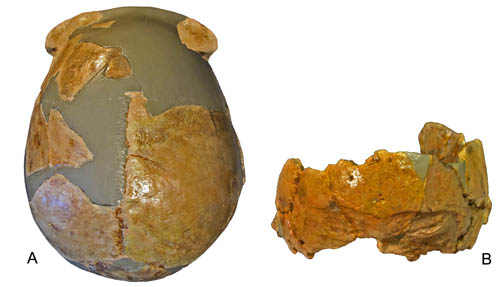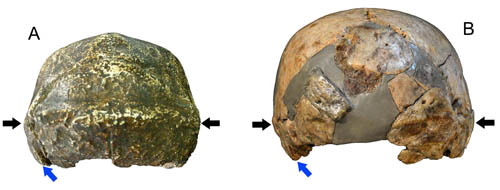
The period between about 200,000 and 50,000 years ago saw the amplification of regional diversity in human biology. Given the fragmentary nature of that human fossil record, the nature of these late Middle and early Late Pleistocene humans in the more northern portions of eastern Eurasia has been unclear. In a study published March 3 in Science, paleontologists from the Institute of Vertebrate Paleontology and Paleoanthropology (IVPP) of the Chinese Academy of Sciences and their collaborators reported two early Late Pleistocene (~105,000- to 125,000-year-old) crania from Lingjing, Xuchang, China. They exhibit a morphological mosaic with differences from and similarities to their western contemporaries. This morphological combination reflects Pleistocene human evolutionary patterns in general biology, as well as both regional continuity and interregional population dynamics.
The Xuchang 1 and 2 crania, excavated in situ in the Lingjing site in Xuchang County of Henan Province between 2007 and 2014, exhibit a distinctive morphological pattern combined with paleobiological trends that appear to have been pan–Old World. They reflect eastern Eurasian ancestry in having low, sagittally flat, and inferiorly broad neurocrania. They share occipital (suprainiac and nuchal torus) and temporal labyrinthine (semicircular canal) morphology with the Neandertals.
The Xuchang 1 and 2 crania were found broken, each cranium dispersed within a circumscribed horizontal area. They were associated with a diverse macromammalian faunal assemblage, rich in Equus, Bos, Megaloceros, Procapra, Cervus, and Coelodonta. The layer contains a Middle Paleolithic lithic industry, along with bone tools on diaphyseal splinters, and it has produced a consistent series of optically stimulated luminescence (OSL) ages, placing the human remains at about 105,000 to 125,000 years, and the overlying layers have provided ages of about 100,000 and 90,000 years. The human crania are therefore securely dated to marine isotope stage (MIS) 5, within MIS 5e or 5d.
The Xuchang early Late Pleistocene archaic human crania exhibit a mosaic morphological pattern. They exhibit features that are ancestral and reminiscent particularly of early Middle Pleistocene eastern Eurasian humans, and derived and shared by earlier Late Pleistocene humans elsewhere, whether morphologically archaic or modern. In common with other early Late Pleistocene humans (whether morphologically archaic or modern), they share neurocranial expansion and gracilization. The endocranial volume (ECV) of Xuchang 1, about 1800 cm3, is at the high end of Neandertal and early modern human variation, and its neurocranium closely approximates the shape of those of Middle Pleistocene humans, especially eastern Eurasians.
In combination with these derived and ancestral features, the Xuchang crania also display two complexes that primarily align them with the Neandertals. They share occipital (suprainiac and nuchal torus) and temporal labyrinthine (semicircular canal) morphology with the Neandertals.
“This morphological combination, particularly the presence of a mosaic not known among early Late Pleistocene humans in the western Old World, suggests a complex interaction of directional paleobiological changes and intra- and interregional population dynamics”, said Dr. WU Xiujie of the IVPP, project designer and co-corresponding author of the study.
“From their fossil record, eastern Asian late archaic humans have been interpreted to resemble their Neandertal contemporaries to some degree, with considerations of whether the fragmentary remains of the former exhibit features characteristic of the latter. Yet it is only with the discovery of two human crania (plus additional elements) from the Lingjing site in Xuchang County of Henan Province, China, that the nature of these eastern Eurasian early Late Pleistocene archaic humans is becoming clear”, said Dr. WU Xiujie.
“The overall cranial shape, especially the wide cranial base, and low neurocranial vault, indicate a pattern of continuity with the earlier, Middle Pleistocene eastern Eurasian humans. Yet the presence of two distinctive Neandertal features—one (iniac and nuchal morphology) unknown among earlier eastern crania, and the other (labyrinthine proportions) evident in only one similarly aged eastern Eurasian fossil—argue for populational interactions across Eurasia during the late Middle and early Late Pleistocene”, said study co-correponding author Dr. Erik Trinkaus from the Department of Anthropology of Washington University in St. Louis, “Similar interactions can be inferred from the presence of Neandertal ancient DNA in western Siberia and in the Tianyuan 1 early modern human from northern China. These data therefore argue both for substantial regional continuity in eastern Eurasia into the early Late Pleistocene and for some level of east-west population interaction across Eurasia”.
The Xuchang crania therefore provide an important window into the biology and population history of early Late Pleistocene eastern Eurasian people. As such, they are a critical piece in our understanding of the human evolutionary background to the subsequent establishment of modern human biology across the Old World, a process that was already underway in eastern Africa and (apparently) further south in eastern Asia.
This work was supported by the National Natural Science Foundation of China, the Chinese Academy of Sciences (CAS).


Fig. 2 Posterior view of the Zhoukoudian Homo erectus (A) and the Xuchang 1 (B) cranium. Black arrow showing a low widest point of the vault; Blue arrow showing a short and inward sloping mastoid process (Image by WU Xiujie)

86-10-68597521 (day)
86-10-68597289 (night)

52 Sanlihe Rd., Xicheng District,
Beijing, China (100864)

